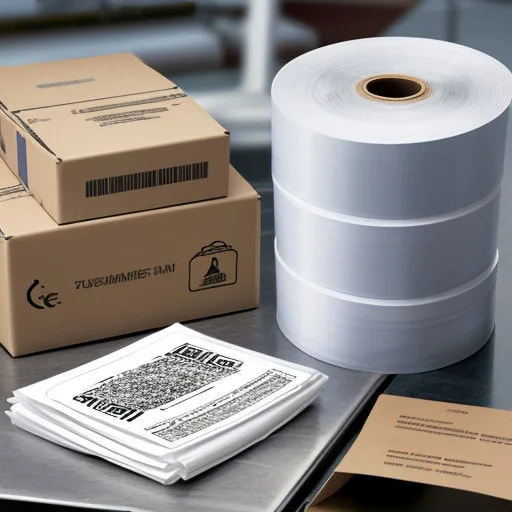
Green logistics is transforming the way supply chains operate, prioritizing sustainability and efficiency. As businesses aim to reduce their carbon footprint, thermal paper emerges as a crucial tool in this eco-friendly revolution. At Sting Bull Ribbon, we offer a diverse range of thermal paper products that are paving the way for greener logistics solutions.
What is Green Logistics?
Green logistics focuses on minimizing environmental impacts by improving energy efficiency, reducing waste, and adopting sustainable materials. It’s an essential approach for businesses seeking to align with global sustainability goals. Whether it’s optimizing routes to reduce fuel consumption or utilizing recyclable materials, every step counts in creating a sustainable supply chain.
The Role of Thermal Paper in Logistics
Thermal paper is a critical component in modern logistics operations, ensuring smooth, accurate, and efficient processes across various stages of the supply chain. From shipping labels to inventory tracking, thermal paper has become indispensable for businesses aiming to enhance productivity and sustainability.
Essential Applications of Thermal Paper
Shipping Labels: Accuracy and Reliability
Shipping labels are the backbone of any logistics operation, as they carry vital information such as tracking numbers, addresses, and barcodes. Thermal paper ensures these details are printed with precision, providing sharp, legible labels that are resistant to smudging or fading. This reliability is crucial for maintaining accurate package tracking and reducing the risk of errors during transit.
Additionally, thermal paper’s fast printing speed helps businesses handle high shipping volumes efficiently. Its durability ensures that labels remain intact, even in challenging conditions like high humidity or extreme temperatures.
Receipts: Quick and Durable Transaction Records
Thermal paper is widely used for printing receipts in logistics, whether for customer transactions, proof of delivery, or internal record-keeping. Its ability to produce clear and long-lasting prints without the need for ink or toner makes it an economical choice.
Receipts printed on thermal paper are resistant to wear and tear, ensuring they remain legible over time. This durability is especially important for records that need to be stored for extended periods, such as financial audits or warranty claims.
Warehouse Management: Efficient Inventory Tracking
In warehouses, thermal paper is essential for creating barcode labels, stock tags, and pallet identification stickers. These labels help streamline inventory management by facilitating quick scanning and real-time updates.
Thermal paper enables warehouses to efficiently track stock levels, monitor product movement, and manage shelf life for perishable items. Its high-speed printing capability ensures operations remain seamless, even during peak periods.
Benefits of Using Thermal Paper in Logistics
Thermal paper’s role in logistics extends beyond its applications. It offers several key benefits that make it a preferred choice for businesses:
Speed and Efficiency: Thermal printers work faster than traditional printers, enabling high-volume operations to meet tight deadlines.
Cost-Effectiveness: Without the need for ink or toner, thermal printing reduces operational costs and maintenance requirements.
Environmental Impact: Modern thermal paper options, such as BPA-free and recyclable variants, support eco-friendly initiatives.
Durability: Thermal paper produces prints that are resistant to smudging, fading, and water damage, ensuring reliable performance in diverse conditions.
Supporting Sustainability Goals
At the heart of sustainable logistics practices is the transition to eco-friendly materials. Thermal paper contributes to these goals by offering recyclable and BPA-free options that minimize environmental impact. Businesses looking to align with sustainability initiatives can explore innovative thermal paper products that combine high performance with environmental responsibility.
By integrating thermal paper into logistics operations, companies can improve accuracy, efficiency, and sustainability, all while meeting the demands of modern supply chains. Its versatility and reliability make it a cornerstone of logistics management, supporting businesses in achieving their operational and environmental objectives.
Eco-Friendly Thermal Paper: A Game-Changer
As sustainability becomes a global priority, eco-friendly thermal paper is revolutionizing the way businesses approach environmental responsibility. By combining functionality with reduced ecological impact, this innovative material is helping organizations align with green initiatives while maintaining high performance.
The Rise of Eco-Friendly Thermal Paper

Eco-friendly thermal paper has emerged as a response to growing concerns about the environmental footprint of traditional thermal paper. Many conventional thermal papers use chemicals like BPA (bisphenol A), which have raised health and environmental concerns. Eco-friendly options eliminate these harmful substances and often incorporate biodegradable or recyclable materials, providing a safer and more sustainable solution.
This shift is not only beneficial for the environment but also aligns businesses with the expectations of eco-conscious consumers and regulatory requirements.
Key Features of Eco-Friendly Thermal Paper
Biodegradability:
One of the standout features of eco-friendly thermal paper is its ability to decompose naturally. Unlike conventional thermal paper, which can linger in landfills for years, biodegradable options break down quickly, reducing waste accumulation and minimizing environmental harm.
BPA-Free and Phenol-Free:
BPA, a common additive in traditional thermal paper, has been linked to health risks and environmental contamination. Eco-friendly thermal paper eliminates BPA and often replaces it with safer alternatives or opts for phenol-free formulations. This makes the paper safer for human contact and reduces the risk of harmful chemicals entering ecosystems.
Recyclability:
Many eco-friendly thermal papers are designed to be easily recyclable, ensuring that used paper can re-enter the production cycle rather than contributing to waste. This supports a circular economy, where resources are reused and repurposed.
Benefits of Eco-Friendly Thermal Paper
Environmental Impact:
By adopting biodegradable, BPA-free, and recyclable thermal paper, businesses significantly reduce their ecological footprint. This not only contributes to environmental protection but also enhances a company’s reputation as a socially responsible organization.
Consumer and Employee Safety:
Eco-friendly thermal paper eliminates exposure to harmful chemicals like BPA, ensuring safer handling for both employees and consumers. This is particularly important in industries such as retail, logistics, and healthcare, where thermal paper is handled frequently.
Regulatory Compliance:
Governments worldwide are imposing stricter regulations on the use of hazardous substances like BPA. Switching to eco-friendly thermal paper helps businesses stay compliant with these regulations, avoiding penalties and ensuring smoother operations.
High Performance:
Eco-friendly thermal paper doesn’t compromise on quality or functionality. Businesses can rely on it for sharp, durable prints that meet the demands of logistics, retail, and other industries.
Leading the Way with Sustainability
Eco-friendly thermal paper is more than just a product; it’s a commitment to doing more good for the planet. By choosing innovative materials from sustainable sources, businesses can play an active role in reducing environmental harm while improving operational efficiency.
As Jochen Zeitz aptly said, “Sustainability is no longer about doing less harm. It’s about doing more good.” This philosophy underscores the importance of adopting materials like eco-friendly thermal paper, which not only reduce damage but also promote positive change.
By exploring options like those available in our thermal paper collection, companies can achieve their sustainability goals without compromising on quality or performance. This is the future of responsible business—a future where environmental stewardship and operational excellence go hand in hand.
Benefits of Thermal Paper in Green Logistics
Thermal paper has become a cornerstone in green logistics, offering a range of advantages that support efficiency, cost reduction, and sustainability. Its unique properties make it a superior choice for businesses aiming to enhance their supply chains while reducing environmental impact.
Why Thermal Paper is Ideal for Green Logistics
Efficiency: Faster and More Accurate Operations
Thermal printing technology is known for its speed and precision. Unlike traditional printing methods, thermal printers do not require ink or toner, allowing for instant printing with minimal maintenance. This speed is crucial in logistics, where high volumes of labels and receipts must be produced quickly to meet tight deadlines.
Furthermore, thermal printers are highly accurate, ensuring that barcodes, tracking numbers, and other critical details are printed clearly. This accuracy minimizes errors, enhances traceability, and keeps operations running smoothly.
Cost-Effectiveness: Reducing Energy and Material Waste
Thermal printing reduces operational costs in multiple ways:
Lower Energy Consumption: Thermal printers use heat to create images, consuming less energy than traditional printers. This efficiency contributes to lower utility bills and aligns with sustainability goals.
No Consumables Needed: By eliminating the need for ink or toner, thermal printers significantly reduce material waste. Businesses can save on consumable costs and minimize the environmental impact of disposing of used cartridges.
Additionally, the durability of thermal paper extends its usability, ensuring fewer reprints and reducing waste further.
Durability: Long-Lasting and Reliable Prints
One of the standout features of thermal paper is its resistance to fading, smudging, and environmental factors like moisture and temperature changes. This durability ensures that labels and receipts remain legible throughout their lifecycle, whether they’re being used in a hot warehouse or a humid shipping container.
In logistics, where reliability is paramount, thermal paper provides a dependable solution for long-lasting documentation and labeling.
Supporting Sustainability with Thermal Paper
Incorporating thermal paper into green logistics not only optimizes operations but also supports broader sustainability initiatives. High-quality thermal paper, such as the options available at Sting Bull Ribbon, offers eco-friendly features like recyclability and BPA-free formulations. These innovations align with the principles of green logistics, helping businesses reduce their environmental footprint.
Additional Advantages of Thermal Paper
Versatility: Thermal paper is used across various applications in logistics, including shipping labels, receipts, and inventory tags. Its adaptability makes it an indispensable tool for modern supply chains.
Ease of Use: Thermal printers are user-friendly and require minimal maintenance, making them an excellent choice for businesses looking to streamline operations.
Consistency: Thermal paper delivers consistent print quality, ensuring professional and accurate outputs every time.
Enhancing Supply Chain Sustainability
By integrating high-quality thermal paper from Sting Bull Ribbon, businesses can take significant steps toward building more sustainable supply chains. From reducing waste to improving operational efficiency, thermal paper is a vital component of green logistics. It empowers companies to achieve their sustainability goals while maintaining the high standards required in modern logistics.
Thermal paper is more than just a practical choice—it’s a sustainable solution that drives innovation and responsibility in supply chain management.
Challenges and Innovations
Transitioning to green logistics is no longer a choice but a necessity in today’s environmentally conscious world. However, this shift is not without its challenges. From high initial costs to infrastructure limitations, businesses face significant hurdles in adopting sustainable practices. Despite these obstacles, innovations in thermal paper technology are paving the way for more accessible and efficient solutions, making green logistics increasingly achievable.

Challenges in Adopting Green Logistics
Cost Considerations:
One of the primary challenges for businesses transitioning to green logistics is the perceived high cost. Eco-friendly materials and sustainable technologies often require upfront investments, which can deter smaller companies or those operating on tight margins.
However, it’s essential to view these costs as long-term investments. Over time, sustainable practices can lead to significant savings through improved efficiency, reduced waste, and compliance with environmental regulations.
Infrastructure Limitations:
Implementing green logistics requires updated infrastructure, such as renewable energy sources, electric vehicles, and efficient waste management systems. In many cases, these upgrades require both time and resources, posing logistical challenges for businesses operating in regions with limited access to green infrastructure.
Consumer Awareness and Demand:
While consumer demand for sustainable products is growing, there is still a gap in widespread awareness about the benefits of green logistics. Educating stakeholders, from consumers to supply chain partners, is vital to creating a collective push toward sustainability.
Innovations in Thermal Paper Technology
Amid these challenges, advancements in thermal paper technology are offering practical solutions that align with green logistics goals. These innovations make it easier for businesses to integrate sustainability into their operations while maintaining high performance and reliability.
BPA-Free and Phenol-Free Thermal Paper:
Traditional thermal paper often contains BPA (bisphenol A) or other phenols, which are chemicals linked to health and environmental risks. Modern innovations have introduced BPA-free and phenol-free thermal paper options, ensuring safer handling for both employees and consumers. These papers meet strict regulatory standards and are ideal for businesses seeking to enhance their sustainability credentials without compromising quality.
Recycled and Recyclable Thermal Paper:
Recycled and recyclable thermal paper is a significant step forward in reducing waste. These papers are manufactured using post-consumer materials and can be recycled after use, supporting a circular economy. Businesses that adopt these options not only reduce their environmental impact but also demonstrate a commitment to sustainable practices.
Durable Thermal Paper for Extreme Conditions:
Logistics operations often involve challenging environments, such as high humidity, extreme temperatures, or rough handling. Innovations in thermal paper technology have resulted in durable options designed to withstand these conditions while maintaining print clarity and integrity. This ensures reliable performance across various applications, from shipping labels to inventory tags.
Building a Sustainable Future with Innovation
These advancements in thermal paper technology, combined with strategic logistics planning, are laying the foundation for a greener future. Businesses can now address challenges like cost and infrastructure by incorporating innovative materials and practices that drive both efficiency and sustainability.
For example, using recycled and BPA-free thermal paper options enhances operational reliability while reducing environmental harm. Coupled with investments in renewable energy sources, route optimization, and eco-friendly packaging, these innovations enable companies to overcome hurdles and establish more sustainable supply chains.
The Path Forward
While the transition to green logistics may present challenges, it also opens doors to transformative opportunities. Businesses that embrace innovations in thermal paper and other sustainable technologies are better positioned to meet evolving consumer expectations, regulatory demands, and environmental goals.
By addressing these challenges head-on and leveraging cutting-edge solutions, companies can contribute to a sustainable future that benefits both the planet and their bottom line. Thermal paper innovations, in particular, are playing a pivotal role in driving this change, proving that sustainability and efficiency can go hand in hand.
Thermal Paper and Smart Technologies
The fusion of thermal paper with emerging technologies like the Internet of Things (IoT) and Artificial Intelligence (AI) is reshaping the logistics industry. By combining the simplicity of thermal printing with the intelligence of smart systems, businesses can achieve unparalleled accuracy, efficiency, and sustainability. This integration is a game-changer, driving innovation while meeting the evolving demands of modern supply chains.
The Role of IoT in Logistics
The Internet of Things (IoT) enables real-time tracking and monitoring of goods throughout the supply chain. Smart labels, powered by thermal paper, play a crucial role in this ecosystem. These labels are equipped with RFID tags or QR codes that provide dynamic information about a product’s location, condition, and status.
For instance:
Real-Time Updates: Smart labels can transmit live data, ensuring complete visibility into shipments. This allows businesses to respond quickly to delays or issues, improving overall efficiency.
Environmental Monitoring: IoT-enabled labels can monitor temperature, humidity, and other environmental factors, ensuring sensitive goods like pharmaceuticals or perishables are handled appropriately.
Thermal paper, known for its clarity and durability, ensures these labels remain legible and functional throughout their lifecycle, even in demanding conditions.
The Power of AI in Logistics
Artificial Intelligence (AI) enhances decision-making in logistics by analyzing large volumes of data to identify patterns, optimize routes, and predict demand. Thermal paper complements AI-driven systems by providing a reliable medium for printing essential data like tracking numbers, barcodes, and shipping instructions.

Key benefits of AI-driven logistics with thermal paper include:
Improved Accuracy: Automated systems reduce human error, ensuring accurate data is printed and processed.
Enhanced Efficiency: AI-powered sorting and routing systems work seamlessly with thermal labels to streamline warehouse and delivery operations.
Waste Reduction: By integrating AI to predict demand and optimize resource allocation, businesses can minimize excess printing and material use.
Smart Labels: Bridging Technology and Sustainability
Smart labels, printed on thermal paper, are the perfect example of technology meeting sustainability. They provide a versatile solution that supports both operational efficiency and environmental goals. Features include:
Dynamic Information Updates: Labels can store and update data in real time, reducing the need for reprinting and saving resources.
Eco-Friendly Materials: Innovations in thermal paper technology, such as BPA-free and recyclable options, ensure that smart labels align with green logistics practices.
Streamlined Returns: Smart labels simplify the return process by embedding essential information, reducing the need for additional paperwork or packaging materials.
Meeting Modern Demands with Thermal Paper
In today’s competitive logistics landscape, businesses must stay agile and forward-thinking. Our thermal paper collection is designed to meet the demands of IoT and AI-driven systems, ensuring high-quality performance across applications. Whether used for smart labels, shipping tags, or inventory management, our thermal paper solutions enable businesses to harness the power of cutting-edge technologies.
The Future of Logistics
The integration of thermal paper with smart technologies is just the beginning. As IoT and AI continue to evolve, so too will their applications in logistics. Businesses that adopt these advancements will not only improve efficiency but also enhance customer satisfaction and sustainability.
By choosing innovative and eco-friendly thermal paper solutions, companies can position themselves as leaders in the industry, ready to adapt to the challenges and opportunities of a rapidly changing world.
A Vision for Sustainable Supply Chains
Building sustainable supply chains requires collaboration, innovation, and the right tools. Thermal paper is more than just a printing medium; it’s a catalyst for change in green logistics. By choosing environmentally friendly options, businesses not only reduce their carbon footprint but also contribute to a healthier planet.
Conclusion
Green logistics and thermal paper are intertwined in the journey toward sustainable supply chains. At Sting Bull Ribbon, our commitment to providing top-quality thermal paper supports businesses striving for eco-friendly solutions. Together, we can create a future where logistics and sustainability go hand in hand.
